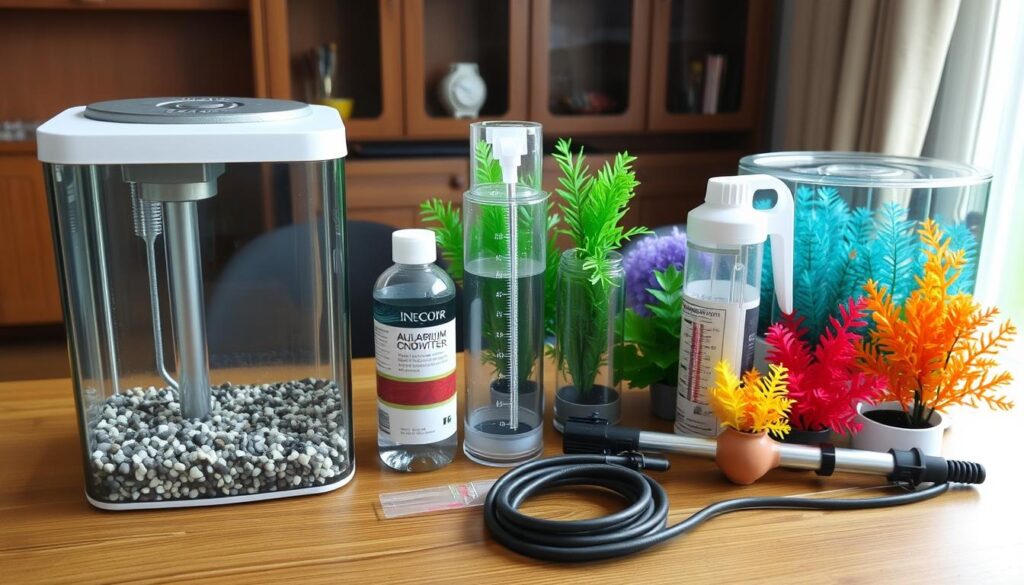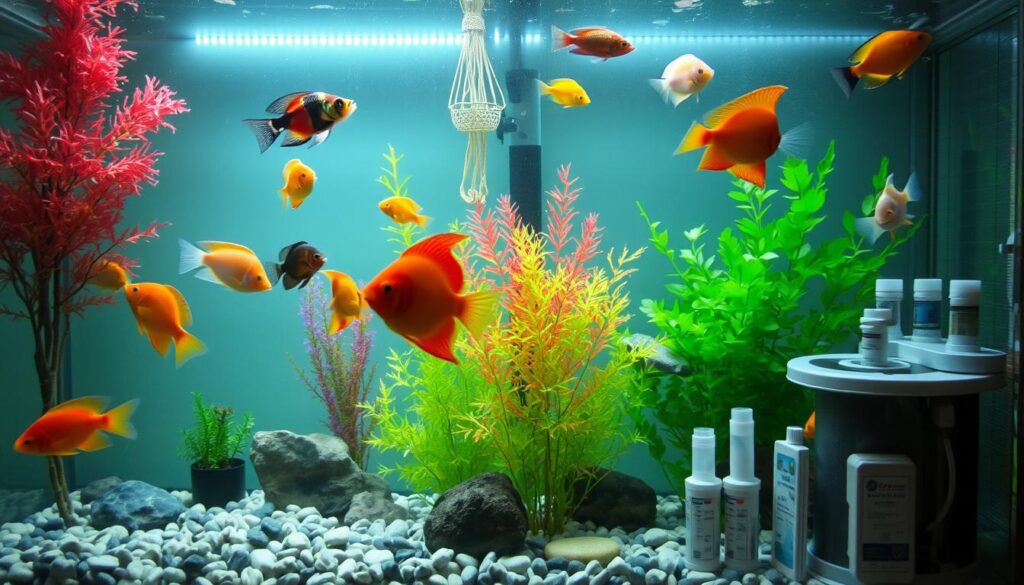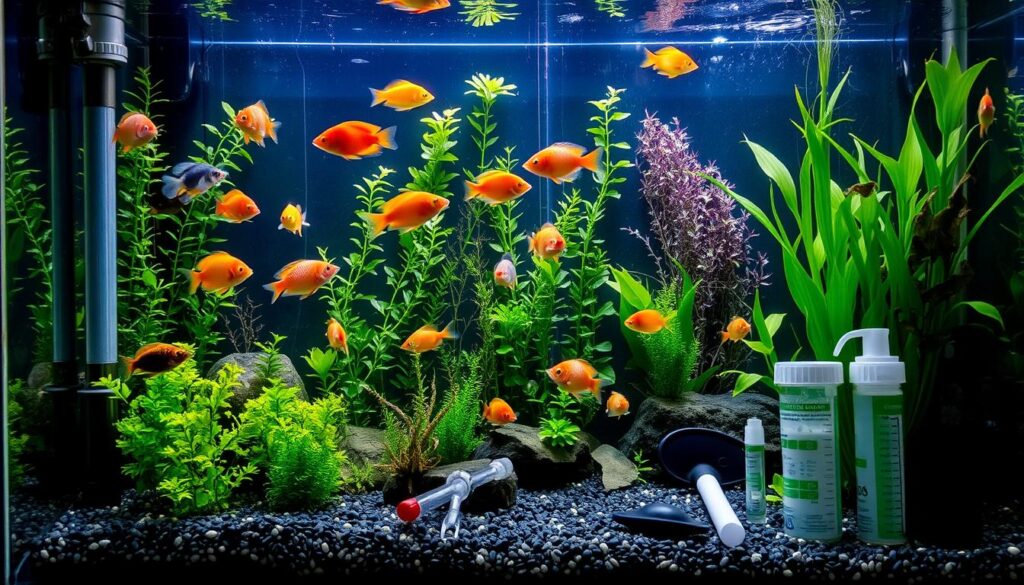Starting your first aquarium can seem overwhelming. But with the right help, you can make a home for your fish. It takes patience and effort, but it’s all worth it. This guide will show you how to set up your first fish tank, from picking the right gear to keeping your fish healthy.
Whether you’re new to aquariums or have experience, this guide has you covered. We aim to teach you the basics of starting a fish tank. You’ll learn how to create a stunning underwater world.
Introduction to Aquarium Setup
This article will cover the key steps to setting up your first fish tank. You’ll learn about choosing the right equipment, finding the best spot, and keeping your fish healthy. By following this guide, you’ll create a thriving home for your fish and enjoy the many perks of having an aquarium.
Key Takeaways
- Learn the basics of how to start a fish tank and create a thriving ecosystem for your fish
- Understand the importance of choosing the right equipment for your aquarium
- Discover the key factors to consider when selecting the perfect location for your fish tank
- Learn how to maintain a healthy environment for your fish and prevent common problems
- Get started with your first fish tank and enjoy the many benefits of aquarium ownership
- Follow this beginner’s guide to fish tank to ensure a successful and enjoyable aquarium experience
Understanding the Basics of Fish Tank Setup
Setting up a fish tank requires knowing the basics for a healthy environment. Fish tank setup tips are available online. But, it’s key to pick the right tank type. For newbies, freshwater aquariums are a good start. They’re simpler to care for and need less knowledge.
There are many aquarium types, like freshwater, saltwater, and brackish water tanks. Each has its own needs and challenges. To avoid mistakes, learn about your tank’s specific needs. Important things to think about include:
- Water quality and filtration
- Temperature and lighting needs
- Choosing the right substrate and decorations
By following setting up fish tank advice and avoiding common errors, you can make a great home for your fish. Always focus on water quality and your tank’s specific needs. This ensures a healthy and happy aquarium.
With the right knowledge and tools, fish keeping can be a rewarding hobby. Whether you’re new or experienced, knowing the basics of setting up a fish tank is key. By using these tips, you can create a stunning and thriving aquarium. It will bring joy and calm to your home.
Choosing the Perfect Location for Your Aquarium
When you start your first fish tank, picking the right spot is key. A good location keeps your fish happy and makes caring for them easier. Look for a place that’s not too sunny, drafty, or too hot or cold.
It’s also important to be close to where you can plug in your tank and get water. You’ll need to power your tank and change the water often.
Avoid placing your aquarium near windows or doors, as this can cause temperature and humidity changes. Choose a quiet spot where your tank won’t get knocked or moved. Make sure the table or stand can hold the weight of your tank and all the equipment.
Some important things to think about when picking a spot for your aquarium include:
- Electrical outlet availability
- Proximity to a water source
- Stability and levelness of the surface
- Avoidance of direct sunlight and drafts
By thinking about these points, you can make a great home for your fish. This will help you succeed in starting your first fish tank.
Essential Equipment for Starting Your First Fish Tank
Starting a fish tank needs the right gear. A good fish tank equipment list keeps your fish healthy. You’ll need a few key items for your tank.
A good filter is key for cleaning the water. There are mechanical, biological, and chemical filters. Make sure your fish tank equipment list has the right filter for your tank.

Filtration Systems Explained
Filtration systems clean the water by removing waste and extra food. They keep the water clean and healthy. A good filter is important for tropical fish.
Lighting Requirements
Lighting is also important. It helps plants grow and keeps fish healthy. You can choose from LED, T5, and T8 lights.
Heating and Temperature Control
Heating and temperature control are crucial. They keep the water stable, especially for tropical fish. A good heater and thermometer are needed to monitor and control the temperature.
Selecting the Right Tank Size and Material
Choosing the right fish tank size is important. You need to think about the space you have, how many fish you want, and the equipment you’ll use. Choosing the right fish tank size is key to a successful aquarium. A bigger tank isn’t always better and can be harder to care for.
Start by thinking about the fish you want. Some, like neon tetras, need to be in groups. Others, like betta fish, prefer to be alone. Choosing the right fish tank size depends on your fish’s needs. Make sure your tank fits your equipment, like filters and heaters.
There are different materials for tanks, like glass and acrylic. Glass tanks are tough and easy to clean. Acrylic tanks are lighter and less likely to scratch. When choosing the right fish tank size, think about the tank material’s impact on your aquarium’s look and upkeep.
Finding the right tank size is all about balance. Consider your space, the fish you want, and your equipment. This way, you can create a vibrant and stunning aquarium that will make you happy for years.
How to Start a Fish Tank: Step-by-Step Process
Starting your first fish tank is exciting but needs careful planning. It’s key to follow a step-by-step guide for a healthy aquarium. This ensures your tank thrives.
First, unpack and set up the tank, filter, and heater. This step is vital. It sets the stage for your aquarium’s success.
Initial Setup and Installation
After setting up the equipment, start the initial setup. Add substrate, decorations, and plants. Remember, leave space for fish to swim and add hiding spots to reduce stress.
Adding Substrate and Decorations
Choosing the right substrate and decorations is crucial. The substrate should be deep for good filtration. Decorations should add beauty and hiding spots. These tips help create a stunning and functional aquarium.
Water Conditioning Methods
Lastly, use water conditioning to remove harmful chemicals. This step is vital for your fish’s safety. By following these steps, you’ll have a thriving aquarium for endless enjoyment.
Understanding Water Chemistry and Parameters
For fish tank maintenance for beginners, knowing water chemistry is key. You need to watch pH, ammonia, nitrite, and nitrate levels. Also, water hardness and alkalinity are important. Regular water changes and good filtration keep the water stable. For more on water chemistry, check out Aquarium Coop’s guide on pH, GH, and KH.
Some key parameters for fish tank maintenance for beginners include:
- pH levels: aim for a stable range between 6.5 and 8.5
- Ammonia and nitrite levels: should be as close to 0 as possible
- Nitrate levels: should be below 20 ppm
- Water hardness and alkalinity: depend on the type of fish and plants in the tank

By following fish tank maintenance for beginners tips and testing water regularly, you can keep your aquarium thriving. Always put your fish’s health first. Act fast if you see any changes in water chemistry or parameter levels.
Cycling Your New Aquarium
Starting a new fish tank is exciting, but cycling it is key. This step lets beneficial bacteria grow. They turn ammonia into nitrite and then nitrate. Knowing the nitrogen cycle and how to check water is crucial for your fish’s health.
Be patient, as cycling can take weeks. You’ll need to watch water parameters closely. This keeps your tank balanced, which is vital for your fish’s well-being.
The Nitrogen Cycle Explained
The nitrogen cycle is a natural process in aquariums. It changes ammonia into nitrite and then nitrate. To start, add ammonia, like fish food or a supplement, to the tank.
Testing Water Parameters
Checking water parameters often is important during cycling. You’ll need to watch ammonia, nitrite, and nitrate levels. Also, keep an eye on pH and water hardness. This helps you spot and fix any problems.
Timeline and Expectations
Cycling usually takes weeks. You’ll need to be patient and check water often. With the right setup and care, your tank will thrive. Learning about the nitrogen cycle will help you succeed as an aquarium owner.
Selecting Compatible Fish Species
When starting your first fish tank, picking the right fish is crucial. This ensures your aquarium is peaceful and healthy. With the right gear, you’ll create a beautiful underwater world.
Start by learning about different fish. Look at their diet, where they live, and how they act. Guppies, neon tetras, and goldfish are great for beginners. They’re easy to care for and colorful.
Beginner-Friendly Fish Options
- Guppies: colorful and peaceful, ideal for small community tanks
- Neon tetras: schooling fish that thrive in groups, adding a mesmerizing display to your aquarium
- Goldfish: a popular choice for beginners, relatively low maintenance and easy to care for
It’s important to pick fish that get along. Some fish can be mean or need special food. Choosing the right fish makes your tank a happy place.
Fish Community Guidelines
A good community is the heart of a great aquarium. Learn about each fish’s needs and ask experts for help. With the right knowledge and gear, your aquarium will soon be a joy to watch.
Creating a Balanced Ecosystem
A balanced ecosystem is key for a healthy aquarium. To get there, focus on fish tank maintenance for beginners. This means picking the right plants, decorations, and fish. Plants soak up extra nutrients, and decorations offer hiding spots and beauty.
For essential fish tank supplies, think about these:
- High-quality filtration systems
- Appropriate lighting for your fish and plants
- A heater to keep the water temperature steady
Adding these elements will help you create a balanced ecosystem. Make sure to learn about your fish and plants’ needs. This will help keep your aquarium harmonious.

With the right mix of plants, decorations, and fish, your aquarium will thrive. Choosing the right essential fish tank supplies will help you create a stunning and healthy space. Your fish will love it.
Essential Maintenance Routines
Keeping your aquarium healthy is key. As a beginner, knowing the basics of fish tank maintenance for beginners and fish tank setup tips is crucial. Daily tasks include feeding your fish, checking the water, and looking for disease signs.
A regular schedule is vital for a well-kept aquarium. Here are some important tasks to add to your routine:
- Daily: Feed your fish, monitor water parameters, and check for signs of disease
- Weekly: Perform water changes, clean the gravel, and check the equipment
- Monthly: Clean the filter, monitor the water quality, and perform a partial water change
By following these fish tank maintenance for beginners tips and fish tank setup tips, you’ll create a healthy aquarium. Always watch your aquarium’s water and adjust as needed to keep your fish healthy.
Regular care is essential for a successful aquarium. By sticking to these routines, you’ll enjoy a thriving aquarium for many years.
Feeding and Nutrition Guidelines
Starting your first fish tank means thinking about your fish’s diet. A balanced diet is key for a healthy aquarium. Find out what food your fish needs and how much. Too much food can harm the water and your fish’s health.
A fish tank equipment list should have good quality food for your fish. You can pick from flakes, pellets, or live/frozen foods. A mix of these foods keeps your fish healthy and happy.
Here are some tips for feeding your fish:
- Feed your fish 2-3 times a day, only as much as they can eat in a few minutes
- Avoid overfeeding, as this can lead to water quality issues and disease
- Provide a variety of foods to ensure a balanced diet
By following these guidelines, you can create a healthy aquarium. Research your fish’s diet and choose the right food. With proper care, your fish will thrive, and you’ll enjoy your new aquarium.
Troubleshooting Common Problems
Starting with fish tank maintenance is key for beginners. Knowing how to fix common problems is crucial. Good setup tips can prevent many issues. But, being ready for unexpected problems is also important.
Monitoring water quality is a must. Poor water can harm fish and break equipment. Issues like algae, low oxygen, and wrong pH levels can happen.
These problems often come from overfeeding, bad filtration, or poor water changes. Following beginner maintenance tips is vital. Regular water tests and equipment upkeep can prevent many issues.
Fish health is another big concern. Diseases or parasites can come from bad water, poor diet, or stress. Watching your fish closely is important. Quick action is needed if you see illness signs.
By following setup tips and maintenance routines, you can avoid many problems. Regular checks help spot issues early. This keeps your fish healthy and happy.
Common Issues to Watch Out For
- Algae blooms
- Low oxygen levels
- Improper pH balance
- Fish disease or parasites
- Equipment malfunctions
Knowing these common issues helps keep your aquarium thriving. Always follow beginner maintenance and setup tips. This ensures a happy, healthy home for your fish.
Plants and Decorations: Creating the Perfect Habitat
When starting your first fish tank, picking the right plants and decorations is key. Plants clean the water, give fish places to hide, and make the tank look natural. Good choices include Java moss, Anacharis, and Amazon swordplants.
Other important essential fish tank supplies like rocks, driftwood, and fake plants add beauty and depth. A good aquarium has a mix of plants and decorations for a balanced look. Here are some tips for picking the best decorations:
- Make sure decorations are safe for your fish.
- Think about your tank’s size and shape when picking decorations.
- Use decorations of different textures and colors for a lively look.
Choosing the right plants and decorations makes your aquarium vibrant and healthy. Always pick essential fish tank supplies that fit your needs. If you’re not sure, ask for advice to make your tank perfect.
Your Path to Aquarium Success: Key Takeaways and Next Steps
Congratulations on finishing our guide to starting a fish tank. By following these steps and keeping up with regular maintenance, you’re on the right track. Stay patient, watch your fish closely, and make sure they have the best home. Soon, you’ll be an expert in keeping your aquarium healthy and beautiful.
As you start your aquarium adventure, remember a few important things. Set up your tank right, check the water often, add fish slowly, and stick to a routine. Being careful and flexible will help you face any problems and enjoy the journey of caring for your fish tank.
Remember, your aquarium’s success is a journey, not just a goal. Learn as much as you can, look for helpful resources, and try new things. With hard work and patience, you’ll create an amazing underwater world to be proud of.
FAQ
What are the different types of aquariums?
There are several types of aquariums. These include freshwater, saltwater, and brackish water tanks. Each type has its own needs and challenges.
What are the key considerations for choosing between freshwater and saltwater tanks?
Freshwater tanks are easy to maintain and common. Saltwater tanks are more complex and need expertise. It’s important to know the needs of each tank type.
What are some common beginner mistakes to avoid when setting up a fish tank?
Beginners often overfeed, have poor filtration, and neglect water quality. Avoiding these mistakes is key to your fish’s health.
What type of filtration system is best for a new aquarium?
A good filtration system keeps water clean and healthy. There are mechanical, biological, and chemical filters to choose from.
How important is lighting for a fish tank?
Lighting is vital for plant growth and fish health. The right lighting depends on your aquarium’s needs.
How do I choose the right tank size and material?
Tank size depends on space, fish number, and equipment. Glass and acrylic are common materials, each with pros and cons.
How do I set up a new fish tank?
Setting up a tank involves several steps. You’ll need to install equipment, add substrate and decorations, and condition the water. Following a step-by-step guide is crucial for success.
What water parameters do I need to monitor in my aquarium?
Monitor pH, ammonia, nitrite, and nitrate levels, as well as water hardness and alkalinity. Regular water changes and good filtration help keep parameters stable.
How long does it take to cycle a new aquarium?
Cycling a tank takes weeks. It involves creating a balance of beneficial bacteria. Be patient and regularly test water parameters during this time.
What are some good beginner-friendly fish species?
Start with hardy species like guppies, neon tetras, or goldfish. Research their needs to ensure a healthy community.
What daily, weekly, and monthly maintenance tasks are required for an aquarium?
Daily tasks include feeding and monitoring water. Weekly tasks include water changes and cleaning. Monthly tasks include filter cleaning and water quality checks.
How do I properly feed my fish and ensure they get the right nutrition?
Learn about your fish’s diet. A balanced diet with various foods is essential for a healthy tank.
How can I troubleshoot common problems in my aquarium?
Common issues include water quality and fish health problems. Address these quickly to keep your tank healthy.
How do I create the perfect habitat for my fish with plants and decorations?
Plants and decorations are key for a natural tank. They absorb nutrients, provide hiding spots, and balance the ecosystem.

